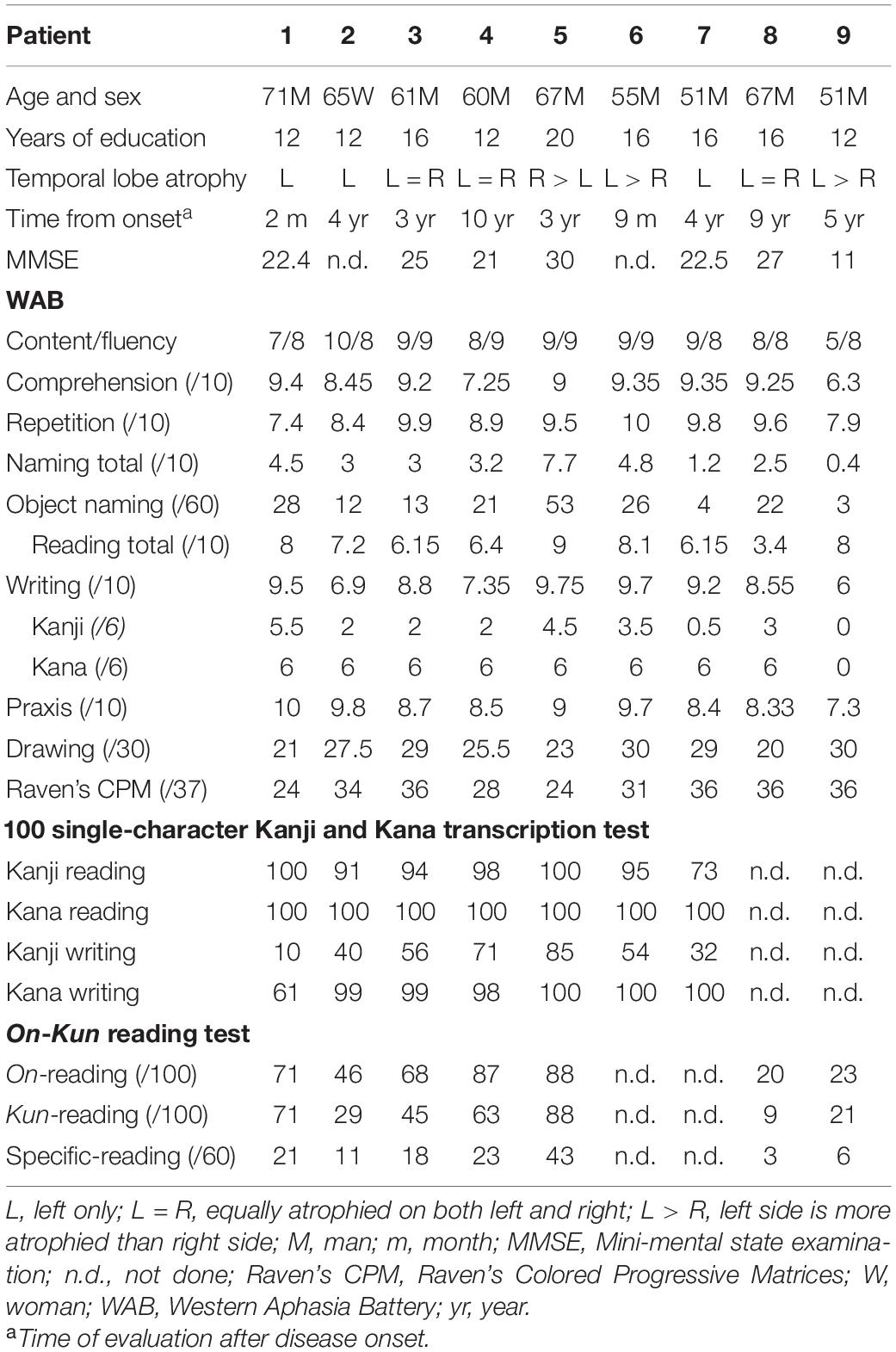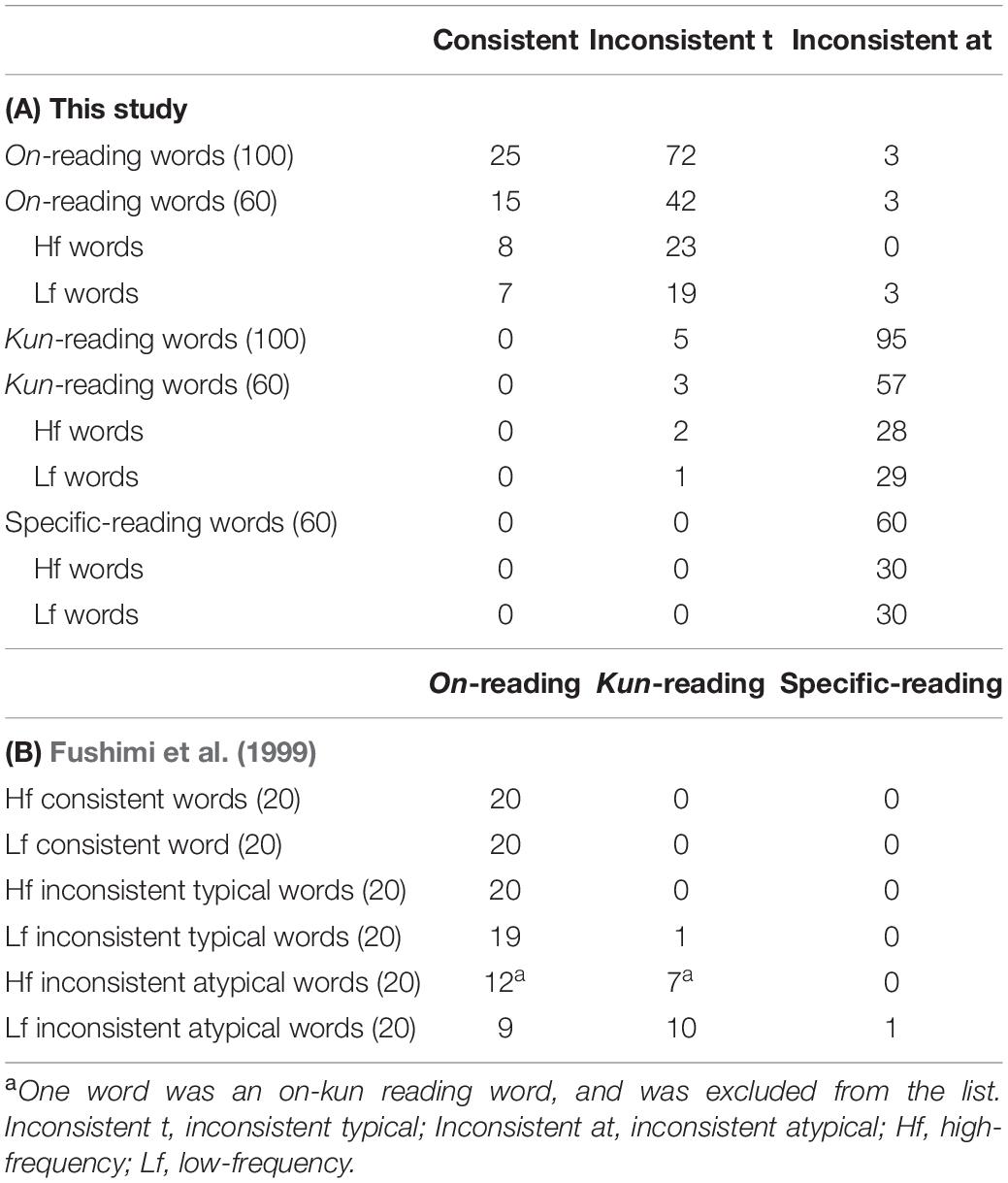- 1Department of Neurology, Mitsui Memorial Hospital, Tokyo, Japan
- 2Department of Neurology, Tokyo Women’s Medical University, Tokyo, Japan
- 3Department of Neurology, Kudanzaka Hospital, Tokyo, Japan
- 4Department of Neurology, Osaka City University Graduate School of Medicine, Osaka, Japan
- 5Department of Cell Physiology, Faculty of Medicine, Kyorin University, Tokyo, Japan
Japanese kanji (morphograms) have two ways of reading: on-reading (Chinese-style pronunciation) and kun-reading (native Japanese pronunciation). It is known that some Japanese patients with semantic dementia read kanji with on-reading but not with kun-reading. To characterize further reading impairments of patients with semantic dementia, we analyzed data from a total of 9 patients who underwent reading and writing tests of kanji and kana (Japanese phonetic writing) and on-kun reading tests containing two-character kanji words with on-on reading, kun-kun reading, and specific (so-called Jukujikun or irregular kun) reading. The results showed that on-reading preceding (pronouncing first with on-reading) and kun-reading deletion (inability to recall kun-reading) were observed in nearly all patients. In the on-kun reading test, on-reading (57.6% correct), kun-reading (46.6% correct), and specific-reading (30.0% correct) were more preserved in this decreasing order (phonology-to-semantics gradient), although on-reading and kun-reading did not significantly differ in performance, according to a more rigorous analysis after adjusting for word frequency (and familiarity). Furthermore, on-substitution (changing to on-reading) errors in kun-reading words (27.0%) were more frequent than kun-substitution (changing to kun-reading) errors in on-reading words (4.0%). These results suggest that kun-reading is more predominantly disturbed than on-reading, probably because kun-reading and specific-reading are closely associated with the meaning of words.
Introduction
Semantic dementia is a phenotype of frontotemporal lobar degeneration (Neary et al., 1998). The cardinal feature is semantic memory loss. Patients with semantic dementia show a severe naming and word comprehension impairment, surface dyslexia, and orthographic agraphia (inability to read or write orthographically irregular words). Characteristically, reading errors comprise regularization errors, e.g., “pint” [paint] is pronounced as [pint], like hint, and writing errors produce a homophone or pseudohomophone effect, a kind of regularization in writing, e.g., “caught” is written as “cort.”
Because Japanese kanji (Japanese morphograms) characters can be read in two ways, on-reading (one type of reading derived from the Chinese pronunciation) and kun-reading (another type of reading derived from the native Japanese language), Japanese patients with semantic dementia show on-kun confusion in reading kanji (Imura, 1943). For example, 真白 [masshiro] (kun-kun reading, meaning “pure white”) is read as [shinpaku] (on-on reading). This kind of on-kun confusion is comparable to regularization errors in Western surface dyslexia (Sakurai et al., 2006). We reported that on-preceding (pronouncing first with on-reading, irrespective of its preferred reading) and kun-deletion (inability to recall and recognize kun-reading) are characteristic of progressive Gogi (word-meaning) aphasia (Sakurai et al., 2006), a Japanese linguistic manifestation of semantic dementia (Imura, 1943).
Since this phenomenon has been observed in only two patients, we retrospectively collected additional data from another seven patients and examined whether on-preceding and kun-deletion were generally observed. Also, we analyzed the results of a special reading test given to the seven patients, consisting of two-character kanji words with on-on reading, kun-kun reading, and specific-reading or irregular word reading (so-called Jukujikun in Japanese). This test was designed to differentiate between on-reading predominance and kun-reading predominance in kanji word reading. What is the clinical significance of differentiating on-reading from kun-reading?
Japanese pupils learn how to pronounce a kanji character by on-reading and kun-reading and learn the meaning by kun-reading. Although on-reading conveys not only its phonetic value but also meaning, semantic attributes of the on-reading are indirectly acquired through the learning of kun-reading of the character and compound on-reading kanji words. In this sense, on-reading primarily conveys its phonetic value.
On the other hand, kun-reading is a Japanese way of reading (a kind of translation) of Chinese characters (Kindaichi, 1988). Thus, kun-reading impairment directly represents a loss of semantics. Moreover, given that specific-reading (Jukujikun) is the semantic assignment of Chinese characters to native Japanese words (Kindaichi, 1988) (e.g., 時雨, the combination of Chinese characters 時 meaning time and 雨 meaning rain is read as Jukujikun しぐれ [shigure], whose native Japanese meaning is occasional rain), Jukujikun can be regarded as irregular kun-reading (Kess and Miyamoto, 1999) whose pronunciation cannot be inferred from any reading of each component character. Therefore, in the case of Jukujikun, whole-word orthography is important in accessing pronunciation and semantics. If whole-word reading is impossible, patients should guess the pronunciation/meaning from the vague semantic context (Kess and Miyamoto, 1999) of the two component characters. In this sense, reading of Jukujikun requires direct or frequent access to semantics, and thus is more closely associated with the meaning.
On the basis of these considerations, we hypothesized that the patients read kun-kun reading words less accurately than on-on reading words, and specific-reading words less accurately than kun-kun reading words because the relationship between irregularity of reading and semantics is more concerned with reading specific-reading words, kun-kun reading words, and on-on reading words in this decreasing order of priority. We further investigated the neural substrate of Japanese semantic dementia, using MRI and single-photon emission computed tomography (SPECT).
Materials and Methods
We retrospectively analyzed data on nine patients with semantic dementia, two of whom were previously reported (patients 6 and 7 in Table 1) (Sakurai et al., 2006). The data included results of reading and writing tests of single-character kanji and kana (Japanese phonetic writing) transcription (Sakurai et al., 1994). We also analyzed the data on seven patients (patients 1 to 5, 8, and 9 in Table 1) undergoing a special reading test of two-character kanji (described below). All authors were qualified neurologists and trained neuropsychologists. They first examined their patients and made a diagnosis of semantic dementia. All patients fulfilled the research diagnostic criteria for semantic dementia or the semantic variant of primary progressive aphasia (Gorno-Tempini et al., 2011) or semantic aphasia and associative agnosia (Neary et al., 1998).
Neuropsychological Assessment
Patients’ language function was rated with Western Aphasia Battery (Japanese edition) (Table 1). Reading and writing were assessed with 100 word single-character kanji and kana transcription (Sakurai et al., 1994), all of which are taught in the first 3 years of primary school in Japan (Supplementary Appendix 1). All kanji characters have both on-reading and kun-reading. A kanji character was rated as accurately read when either the on-reading or kun-reading was accurately named. Besides usual error analysis, we counted the occurrence of preceding on-reading and kun-reading deletion. That is, when a patient read a kanji character with on-reading, he was asked to read the character with kun-reading. This is because a kanji character is mostly read with kun-reading when presented in isolation (described in Discussion). Thus, reading first with on-reading is unusual in many cases. In addition, forgetting kun-reading directly represents a loss of semantics, as described in Introduction.
Furthermore, to determine the effects of visual complexity (measured by the number of writing stroke sequences), concreteness (Kitao et al., 1977), familiarity (Kitao et al., 1977), frequency (Amano and Kondo, 2000), and imageability (Sakuma et al., 2008) in writing a kanji character, we divided the test characters into two groups (above or under a median) nearly equal in number: a more complex (more writing stroke sequences), concrete, familiar, frequent or imageable group and a less complex, concrete, familiar, frequent, or imageable group. We compared the number of correct responses between the two groups.
Another reading test of two-character kanji called the on-kun reading test, consisting of 100 on-on reading words [e.g., 水泳 (sui-ei), swimming], 100 kun-kun reading words [e.g., 草花 (kusa-bana), grasses and flowers], and 60 specific-reading words called Jukujikun [e.g., 七夕 (tana-bata), star festival], was performed (Supplementary Appendix 2). All of the kanji characters were selected from those learned in primary and junior high schools in Japan.
The frequency was evaluated with articles covered in a Japanese newspaper from 1985 to 1998 (Amano and Kondo, 2000). Because the raw frequency values ranged from 1 to over 80,000, they were transformed to common logarithmic values. The mean transformed values were mutually different: 3.47 for on-reading, 2.64 for kun-reading, and 2.98 for specific-reading. On the other hand, the mean written-word familiarity values assessed on a seven-rating scale (Amano and Kondo, 2000) were also mutually different: 5.94 for on-reading, 5.62 for kun-reading, and 5.78 for specific-reading.
To control frequency and familiarity across the three types of reading tests for detailed analysis, we selected 60 words with consecutive or every-other frequency values from 100 word on- and kun-reading tests so that the mean and SD might be close to those of the specific reading test (Supplementary Appendix 2). Thus, the mean (SD) frequency was 2.97 (0.69) for on-reading, 2.95 (0.75) for kun-reading, and 2.98 (0.74) for specific-reading, whereas the mean familiarity (SD) was 5.85 (0.49) for on-reading, 5.72 (0.50) for kun-reading, and 5.78 (0.49) for specific-reading. To determine how frequency and familiarity influenced the correct responses, we further divided test words into two groups (above or under a median) nearly equal in number: a more frequent, familiar group and a less frequent, familiar group. We compared rate of correct responses (% correct) between the two groups.
Neuroimaging Study
MRI T2-weighted images were obtained from eight patients (MRI images of patient 7 were missing). We assessed temporal lobe atrophy focusing on the dilatation of the inferior horn of the lateral ventricles. Imaging data on single photon emission computed tomography with a 99mTc-ethylcysteinate dimer (99mTc-ECD-SPECT) were obtained from seven patients (Patients 1 to 5, 8, and 9). First we compared each patient’s images with a normal subject database of the same generation and sex by the t-test (uncorrected p < 0.001), and then the seven patients’ data compared with each of the generation and sex groups were averaged using analysis of covariance (ANCOVA) by subject (multi-subject; condition (patient vs. healthy controls) by subject interaction, uncorrected p < 0.001). Inter-laboratory data correction was made possible with easy Z-score Imaging System (eZIS) (Matsuda et al., 2004). This system incorporates programs for realignment, spatial normalization, and smoothing from Statistical Parametric Mapping (Friston et al., 1995) version 2 (SPM2), and statistical analysis was conducted with SPM2 implemented in MATLAB 6.5.1. In each analysis, the extent threshold was set to be equal to the expected voxels per cluster to avoid noise clusters.
Results
Patient profiles and neuropsychological data are shown in Table 1. In the WAB test, fluency, repetition, comprehension, reading, and writing were relatively preserved, whereas naming and kanji writing were impaired to various extents. Patient 5 achieved the highest scores in the WAB test and the on–kun reading test. However, he named a hammer “something to remove a staple.” A phonemic cue did not help. Even when the examiner taught him the correct answer, he did not identify it. This symptom was characteristic of semantic dementia and met a core feature of diagnostic criteria for semantic dementia (Neary et al., 1998; Gorno-Tempini et al., 2011). Also, the lowest score for the specific reading in the on–kun reading test suggested loss of semantics attached to the whole-word. The patient showed right-predominant temporal lobe atrophy, being consistent with the finding that anomia was less severe in patients with right-predominant atrophy than those with left-predominant atrophy (Woollams and Patterson, 2018).
Kanji and Kana Reading and Writing Test
Mean correct responses in the kanji and kana reading and writing tests were the lowest for kanji writing, followed by kana writing and kanji reading (Figure 1). Errors of kanji reading were classified into visual (changing to a visually similar character), semantic (changing to a semantically related character), and phonological (phonemic paralexia), etc (Sakurai et al., 2000) according to a published English textbook (Coltheart, 1987). Error analysis revealed that in the kanji reading test, visual (18 out of a total of 33 errors) and semantic (8 out of 33 errors) errors accounted for most errors (details of the error types are shown in Supplementary Table S1). On-preceding was observed in all 7 patients (total of 92 characters), and kun-deletion was observed in 6 of the 7 patients (total of 32 characters). Errors of kanji writing were also classified into visual, semantic, and phonological, etc., similar to the reading (Supplementary Table S2). In the kanji writing test, no response was the most frequent (78% of all errors), and other orthographic errors including partial responses and visual errors were also frequent (10% of all errors).
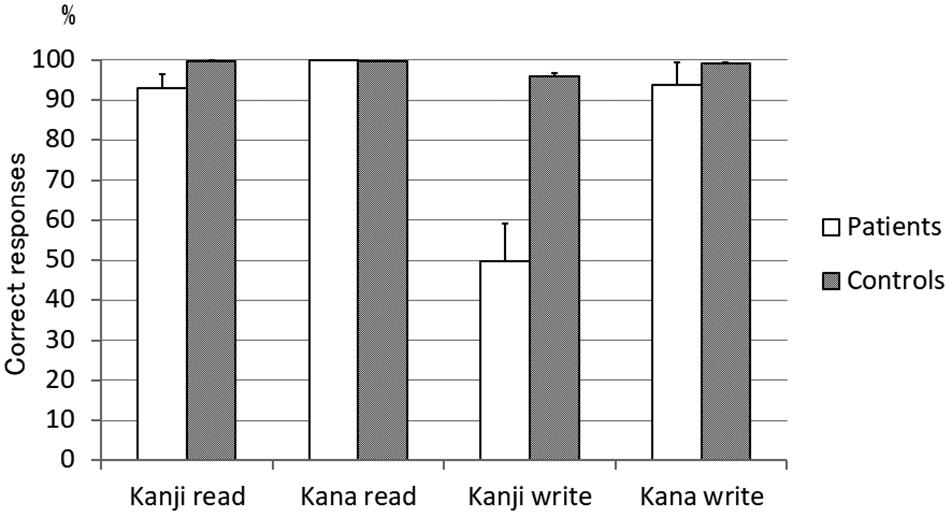
Figure 1. Mean rate of correct responses in the 100 single-character kanji and kana transcription test. Kanji writing was the most impaired. Kana writing and kanji reading were equally slightly impaired (n = 7). Error bar denotes standard error.
Individual analysis of kanji writing revealed that the correct scores were significantly different in complexity (p < 0.01 by Fisher’s exact method) for 6 of 7 patients, frequency (p < 0.05 by Fisher’s exact method) for 4 of 7 patients, and familiarity (p < 0.01 by Fisher’s exact method) for 3 of 7 patients. That is, less complex, more frequent, and more familiar characters were written more easily, although these variables may not have been mutually independent: less complex kanji characters tended to be more frequent, familiar, and concrete.
Kanji On-Kun Reading Test
The mean rate of correct responses for the on-kun reading test showed that on-reading (57.6%), kun-reading (46.6%), and specific-reading (30.0%) were more preserved in this decreasing order (Figure 2). A two-way repeated-measures analysis of variance (ANOVA) was conducted of the correct response rate, with reading type (on-on reading, kun-kun reading, and specific-reading) and group (patients vs. normal controls) as factors. The results showed the main effects of reading type [F(2,32) = 32.84, p < 0.001], group [F(1,16) = 46.59, p < 0.001], and interaction of reading type and group [F(2,32) = 22.73, p < 0.001]. A one-way repeated-measures ANOVA for reading type of the patient group also showed the main effect of reading type [F(2,12) = 19.52, p < 0.001], and post-hoc contrast revealed on-reading advantage over kun-reading (p = 0.034), on-reading advantage over specific-reading (p = 0.002) and kun-reading advantage over specific-reading (p = 0.006).
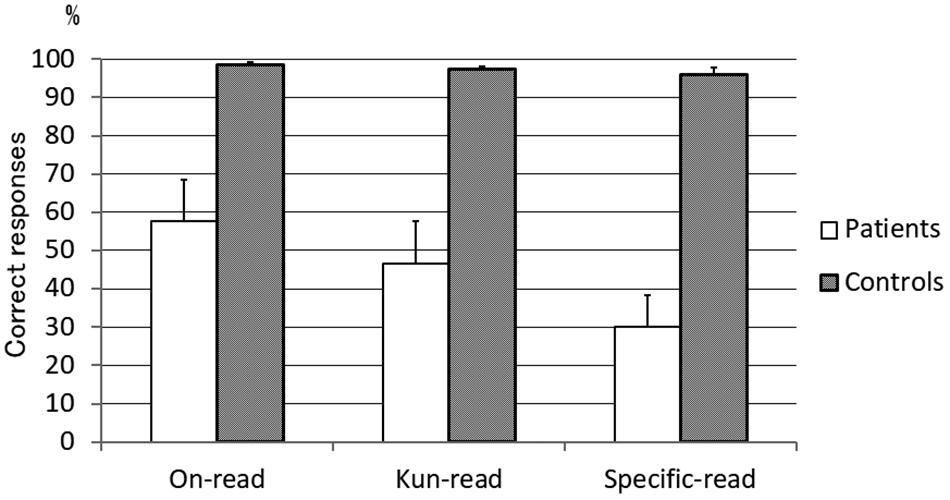
Figure 2. Mean rate of correct responses in the on-kun reading test. Specific-reading was the most impaired, then kun-reading, and on-reading was less impaired (n = 7). On-reading words = 100 words, Kun-reading words = 100 words, Specific-reading words = 60 words. Error bar denotes standard error.
The mean % correct high- and low-frequency words and high- and low-familiarity words was calculated in the frequency- (and also familiarity-) matched 60 word on-reading, kun-reading, and specific-reading tests (Figure 3). As shown, high-frequency or high-familiarity words were read more accurately than low-frequency or low-familiarity words in each reading test. A two-way repeated-measures ANOVA for frequency and reading type showed the main effect of frequency [F(1,6) = 30.70, p = 0.001] and reading type [F(2,12) = 13.24, p = 0.001], without interaction. Post-hoc contrast revealed an on-reading advantage over specific-reading (p = 0.005) and a kun-reading advantage over specific-reading (p = 0.004), but not on-reading advantage over kun-reading. ANOVA for familiarity and reading type also showed the main effect of familiarity [F(1,6) = 48.27, p < 0.001] and reading type [F(2,12) = 13.59, p = 0.001], without interaction. Post-hoc contrast revealed an on-reading advantage over specific-reading (p = 0.005) and a kun-reading advantage over specific-reading (p = 0.004), but not on-reading advantage over kun-reading.
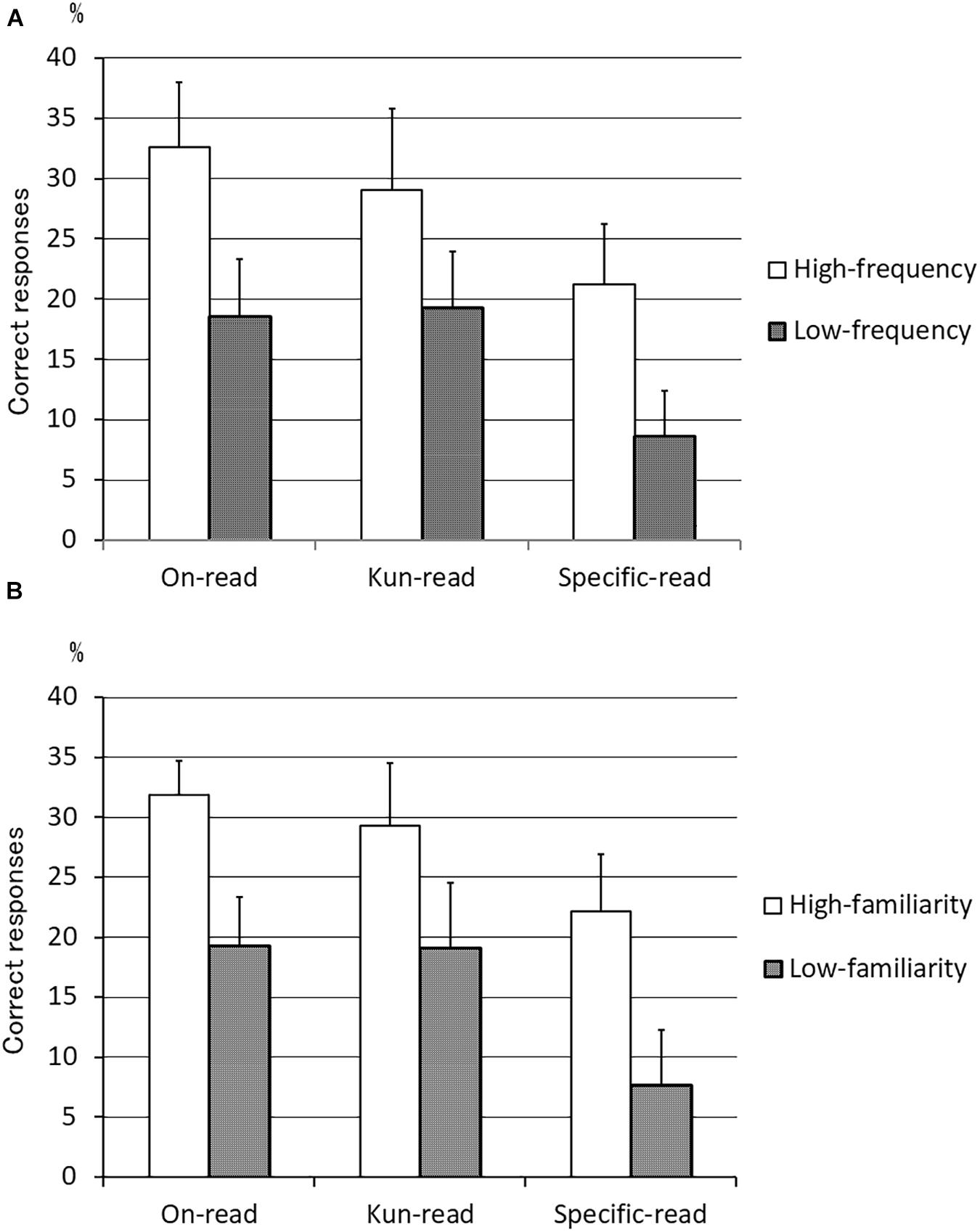
Figure 3. Mean rates of high- and low-frequency words and high- and low-familiarity words with correct responses in the on-kun reading test. (A) Mean % correct high- and low-frequency words. (B) Mean % correct high- and low-familiarity words. High-frequency or high-familiarity words were read more accurately than low-frequency or low-familiarity words in each reading test. On-reading predominance over kun-reading (not significant) and kun-reading predominance over specific-reading were observed only with high-frequency or high-familiarity words (n = 7). On-reading words = 60 words, Kun-reading words = 60 words, and Specific-reading words = 60 words. Error bar denotes standard error.
Next, we classified error types of reading, following those of the 100 kanji and kana reading and writing test (Sakurai, 2004) (Supplementary Table S3). Specifically, we examined the rate of substitution errors in each reading test (Figure 4). On-substitution denotes one or two substitutions of on-reading for kun-reading, e.g., 北風 [kita-kaze], kun-kun reading, meaning “north wind” → [hoku-huu], on-on reading, or 若者 [waka-mono], kun-kun reading, meaning “youth” → [waka-sha], kun-on reading. Kun-substitution denotes one or two substitutions of kun-reading for on-reading, e.g., 森林 [shin-rin], on-on reading, meaning “forest” → [mori-bayashi], kun-kun reading, or 親切 [shin-setsu], on-on reading, meaning “kindness” → [shin-kiri], on-kun reading. On-substitution in kun-kun reading words (27.0%) was significantly more frequent than kun-substitution in on-on reading words (4.0%) (p = 0.018 by Wilcoxon signed rank test). Also, on-substitution errors in kun–kun reading words were higher than that in specific-reading words, but not significant (p = 0.091 by Wilcoxon signed rank test). In specific-reading words, there was no significant difference of frequency between on-substitution errors and kun-substitution errors (p = 0.75 by Wilcoxon signed rank test).
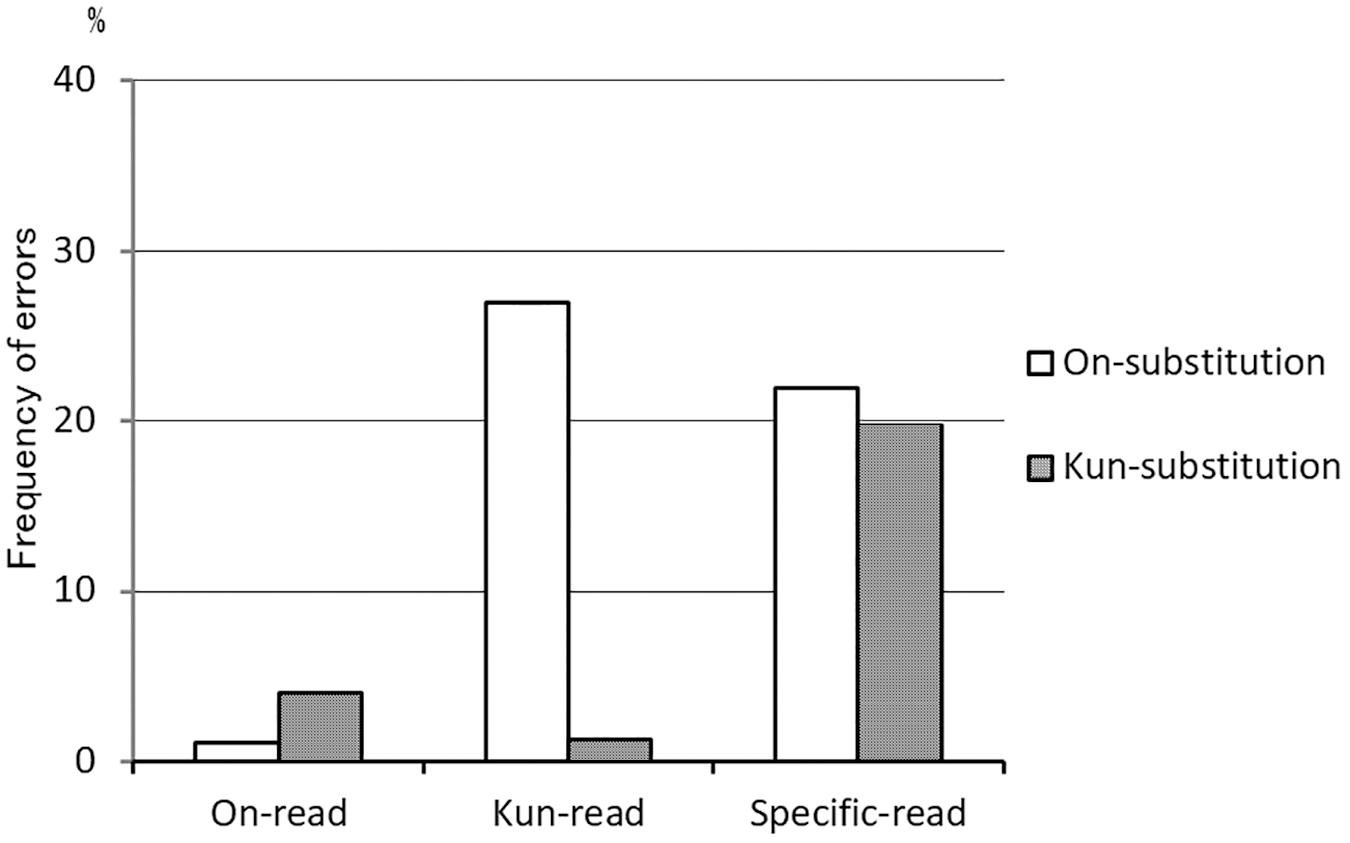
Figure 4. Frequency of substitution errors in the on-kun reading test. On-substitution errors in kun-reading words (27.0%) were more frequent than kun-substitution errors in on-reading words (4.0%) (p = 0.018 by Wilcoxon signed rank test). In specific-reading words, on- and kun-substitution errors were nearly equal in number (n = 7). On-reading words = 100 words, Kun-reading words = 100 words, and Specific-reading words = 60 words.
MRI and ECD-SPECT Findings
On MRI T2-weighted images, temporal lobe atrophy was left-sided only in three (patients 1, 2, and 7), left-right involvement was nearly equal in three (patients 3, 4, and 8), it was right-predominant in one (patient 5), and left-predominant in two (patients 6 and 9) (Table 1 and Figure 5). ECD-SPECT images showed temporal hypoperfusion that was nearly equivalent to the atrophy on MRI (Figure 6). Only two patients (3 and 8) showed left-predominant hypoperfusion in contrast to symmetrical temporal lobe atrophy. Averaged surface images revealed left-predominant hypoperfusion, involving the frontal operculum, and anterior temporal lobe extending to the mid-fusiform gyrus, suggesting that the lesion extension to the mid-fusiform gyrus is critical in producing anomia and alexia with agraphia in semantic dementia.
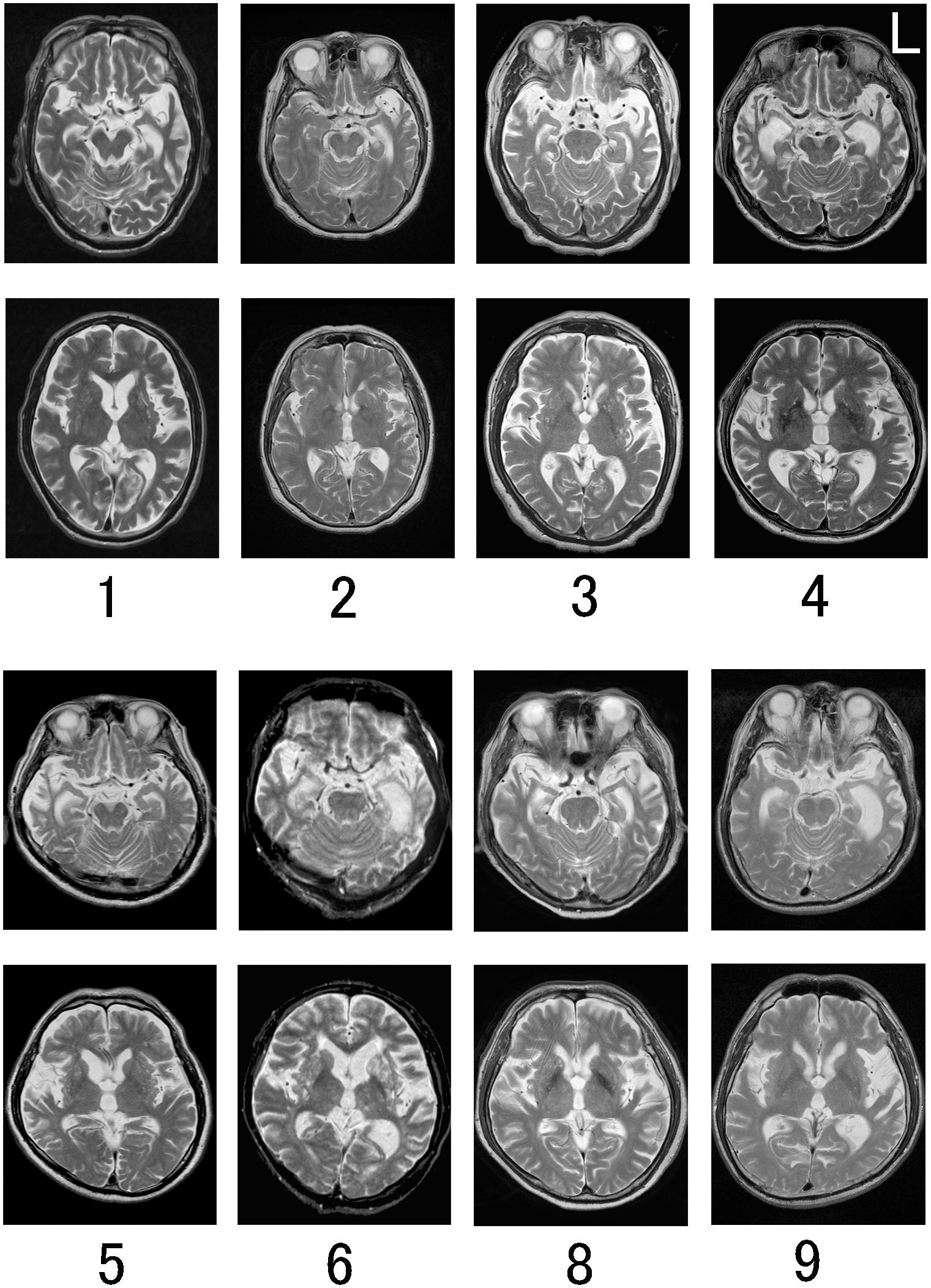
Figure 5. MRI T2-weighted images of eight semantic dementia patients. Number corresponds to the patient number in Table 1. MRI of patient 7 is not shown. Temporal lobe atrophy was left-sided only (Patients 1 and 2), left-right nearly equal (Patients 3, 4, and 8), right-predominant (Patient 5), and left-predominant (Patients 6 and 9).
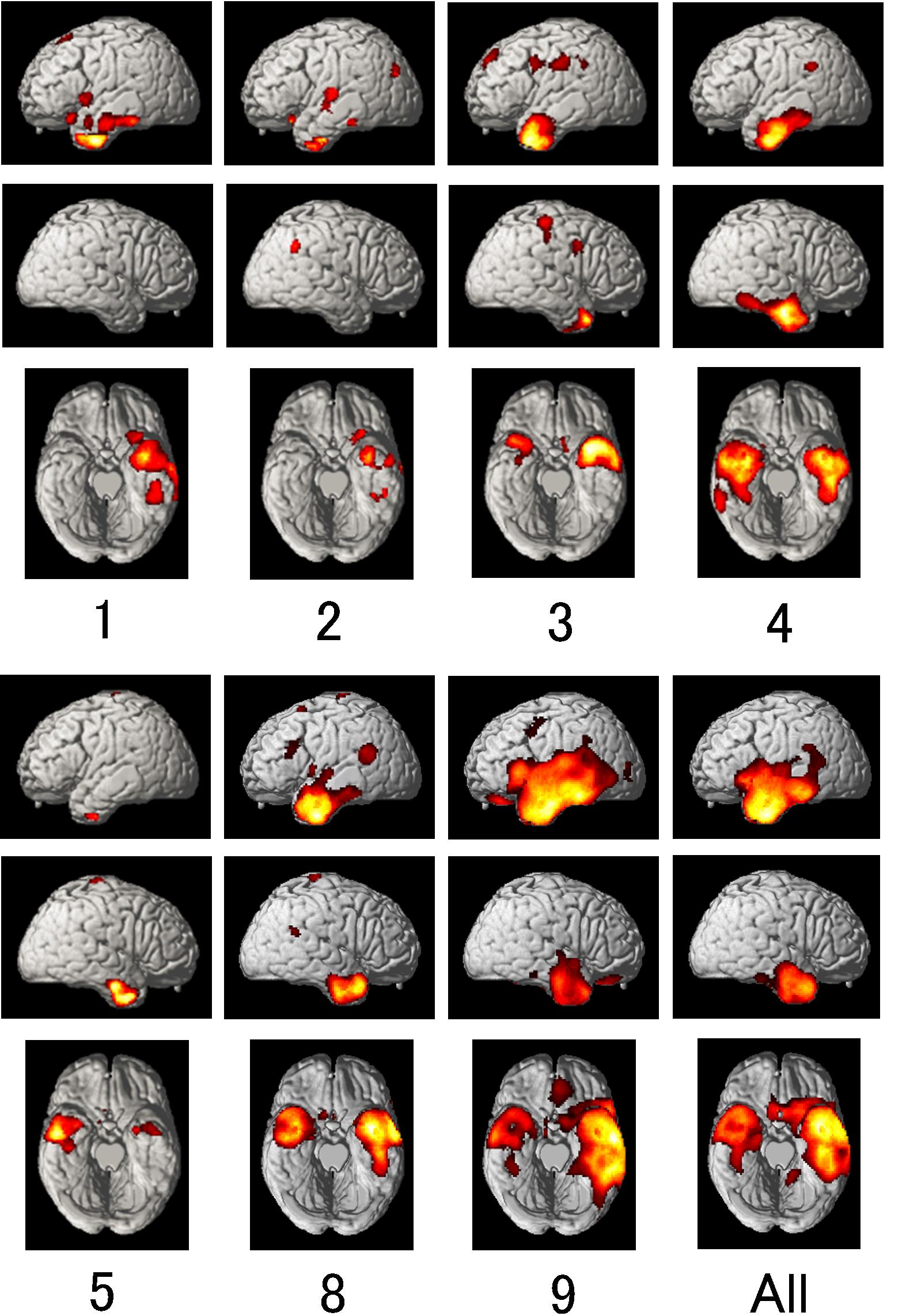
Figure 6. ECD-SPECT images of the 7 patients individually and altogether. Number corresponds to the patient number in Table 1. Each patient’s images were compared with those of normal subjects of the same generation and sex, using easy Z-score Imaging System (eZIS) and Statistical Parametric Mapping version 2 (SPM2). Areas of hypoperfusion (uncorrected p < 0.001 on t-test for individual analyses and analysis of covariance for all patients) are presented with a red-to-yellow gradient representing increasing z-scores. Temporal lobe hypoperfusion was left-predominant (Patients 1–3, 8, and 9), right-predominant (Patient 5), and left-right nearly equal (Patient 4). Averaged surface images revealed left-predominant hypoperfusion, involving the left posterior inferior frontal gyrus and anterior temporal lobe extending to the mid-fusiform gyrus. Areas with local maximum blood flow reduction in the temporal lobe were the left anterior and middle inferior temporal gyrus and mid-fusiform gyrus [Brodmann area (BA) 20; (–40, –4, –40), (–42, –24, –28), (–46, –42, –26)] and the right anterior temporal pole and middle and inferior temporal gyrus [BA 21; (42, 12, –32), (56, –8, –22), (42, –8, –34)] on the Montreal Neurological Institute (MNI) coordinate.
Discussion
In the present study, on-preceding was observed in all 7 patients tested, and kun-deletion was observed in 6 of the 7 patients. This is consistent with our previous report that on-preceding and kun-deletion were characteristic of Japanese semantic dementia (Sakurai et al., 2006). In addition, on-reading, kun-reading, and specific-reading were significantly more preserved in this decreasing order (Figure 2). A more rigorous analysis after adjusting for word frequency (and familiarity) revealed that this trend, a kind of semantic effect that we call the phonology-to-semantics gradient, was not significant between on-reading and kun-reading. It is impossible, however, for the frequency or familiarity to directly create this gradient because the score for the kun-reading, whose mean frequency or familiarity was the lowest (described in Neuropsychological assessment), did not remain the lowest. Instead, it is possible that a reduction of test items from 100 to 60 is insufficient to detect the on-kun difference.
It is also possible that some patients do not exhibit on-reading superiority. Namely, the semantic dementia patients may comprise two groups: those in whom kun-reading is more impaired than on-reading (patients 2, 3, 4, and 8), and the others in whom kun-reading impairment is not so marked (patients 1, 5, and 9). We previously reported a patient with left temporal lobe hemorrhage who exhibited selective impairment of on-reading with preserved kun- and specific (Jukujikun) reading (Yoshida et al., 2020). This case, together with the present case of predominantly impaired kun-reading, supports a double dissociation between on-reading and kun-reading, and suggests that the phonological lexicon of on-reading and kun-reading is differently located in the temporal lobe. Taken together, it is possible that some semantic dementia patients exhibit kun-reading predominant impairment, whereas others exhibit not only kun-reading impairment but also on-reading impairment.
Although it is difficult to elucidate the relationship between the on–kun differences in reading and the temporal lobe atrophy/hypoperfusion, it is likely that on-reading predominance is observed in patients with left-only (patient 2), left-predominant (patients 3 and 8), or left-right nearly equal hypoperfusion (patient 4), whereas on-reading predominance is not so pronounced in patients with extensive temporal lobe hypoperfusion (patient 9), or right-predominant hypoperfusion (patient 5). Patient 1 with left-only hypoperfusion did not exhibit on-reading predominance, probably because the patient’s learning level of kanji may have confounded the test results.
Of particular note, on-substitution (changing to on-reading) errors in kun-reading words were significantly more frequent than kun-substitution (changing to kun-reading) errors in on-reading words (Figure 4). This result could be anticipated because two-character kanji words are mostly read with on-reading. For example, a standard Japanese kanji dictionary (Kimura and Kurosawa, 1996) contains 95.8% on-on reading, 3.1% kun-kun reading (including Jukujikun), 0.5% on-kun reading, and 0.6% kun-on reading words in a total of approximately 24,200 two-character kanji words excluding personal names. The on-substitution predominance (on-reading substitution errors are more frequent than kun-reading substitution errors) was also observed in the healthy subject group (Supplementary Table S3). However, the difference is that patients made more than six times as many on-substitution errors as healthy subjects (on/kun substitution ratio: 7 patients 189/9 vs. 11 controls 13/4) in the kun-reading word test. This is because patients did not recall the correct kun-reading, and thus depended on the residual on-reading. These findings suggest that kun-reading and specific-reading (Jukujikun) are more predominantly disturbed than on-reading in Japanese semantic dementia, probably because kun-reading is closely associated with the meaning of words, as described in Introduction. The same may apply to Western semantic dementia. Namely, patients with semantic dementia have difficulty reading irregular or exceptional words (surface dyslexia) because the pronunciation of these words inevitably involves accessing the original meaning, which patients progressively lose.
In summary, our study revealed that the on-kun difference had a distinct effect on the reading score. That is, the highest score for on-reading words with few kun-substitution errors suggests that on-reading, which primarily conveys phonetic values, was relatively preserved, whereas the relatively lower score for the kun-reading words with abundant on-substitution errors suggests that kun-reading, which directly links to the meaning, was selectively lost and the defect was compensated for with preserved on-reading. Moreover, the lowest score for specific-reading words suggests that specific-reading, of which the whole-word image directly links to the meaning, was markedly deteriorated and the defect was compensated for with either residual on- or kun-reading of the constituent kanji character.
The reason why there were not more on-substitution errors in the specific-reading test may be as follows. Although patients could not retrieve the whole-word reading, they obtained some semantic information from the combination of two characters. This vague semantic context effect (described in Introduction) may have helped to recall semantics-associated kun-reading of the individual kanji.
The on-kun confusion in Japanese semantic dementia suggests that the extent to which semantics is concerned with the pronunciation of the word (phonology-to-semantics gradient) determines the severity of surface dyslexia in semantic dementia.
Relationship Between On-Kun Difference and Consistency
It has been shown that word frequency, familiarity, lexicality, and regularity (or consistency) influence the reading performance in semantic dementia (Jefferies et al., 2004; Patterson et al., 2006; Fushimi et al., 2009; Wilson et al., 2009; Playfoot et al., 2018). Characteristic is a frequency-by-regularity interaction in which the patients’ worst performance is on low-frequency irregular or exceptional words (Jefferies et al., 2004; Wilson et al., 2009). Similarly, in the Japanese language, a frequency-by-consistency interaction was reported (Fushimi et al., 2009). This phenomenon is explained as follows. Many kanji characters have multiple on-reading or kun-reading possibilities (Tamaoka et al., 2017). Fushimi et al. (2009) classified two-character kanji words into consistent (definite pronunciation in each position of a word), inconsistent typical (probable pronunciation), and inconsistent atypical (possible or improbable pronunciation), according to the probability of reading (frequency of being read in a Japanese dictionary), and reported that the frequency effect was more pronounced in this order of irregularity.
In our study, frequency also influenced the reading performance of on-reading words, kun-reading words, and specific-reading words (Figure 3). However, the reading type did not interact with frequency, which was attributed to the fact that there was little difference in the score between on-reading and kun-reading. This is partly because some semantic dementia patients did not exhibit on-reading predominance, as described in the previous session. Another factor associated with the lack of interaction is that the word lists were originally high-frequency words: we divided the words as relatively high frequency or relatively low frequency according to the median. Thus, the low-frequency words were actually “relatively lower” frequency words in a high-frequency word group. In order to precisely examine the interaction between reading type and frequency, we have to select high-frequency words and low-frequency words in a literal sense.
According to Fushimi et al.’s classification, our on-reading words are mostly inconsistent typical, and kun-reading and specific-reading words are mostly inconsistent atypical (Table 2A). In this regard, consistent words are, in fact, rare. Our study suggests that: (i) the distinction of inconsistent typical words and inconsistent atypical words or on-reading words and kun-reading words is not so robust: the difference was observed only in abundant 100 word lists; and (ii) inconsistent atypical words are further divided into kun-reading words and specific-reading (Jukujikun) words, on the basis of the fact that these two reading-types showed distinct reading performances in semantic dementia patients. This is because Jukujikun has an irregular kun-reading that cannot be predicted from the kun-reading of the two component characters (described in Introduction), and thus requires a direct link between the whole-word orthography and meaning. Although it is difficult to find words corresponding to Jukujikun in English, loanwords such as “yacht” may be similar to Jukujikun in that the pronunciation is extremely exceptional and requires a direct link between orthography and semantics.
Conversely, in Fushimi et al.’s (1999) stimulus word list, consistent and inconsistent typical words comprised nearly all on-reading words, and inconsistent atypical words comprised kun-reading words more in low-frequency words (Table 2B). This fact suggests that the involvement of kun-reading and specific-reading words in the inconsistent atypical words contributed to reducing the reading performance.
It remains to be elucidated which is more important, consistency-inconsistency or on-kun difference, in reading words with semantic dementia. Roughly speaking, our on-reading words correspond to inconsistent typical words whereas kun-reading words correspond to inconsistent atypical words. However, this relationship is reversed when the Japanese read a single kanji character. That is, when kanji appear in compounds, they are expected to be pronounced with on-reading. In contrast, when kanji appear in isolation, they usually take a kun-reading (Kess and Miyamoto, 1999). Thus, when reading single characters, kun-reading becomes inconsistent typical, whereas on-reading becomes inconsistent atypical. The fact that patients show on-reading preceding and kun-reading deletion when reading single-character kanji implies that they read a kanji character with on-reading or inconsistent atypical (possible or improbable) reading. This is contradictory given that inconsistent typical reading is more frequently used than inconsistent atypical reading. It should be noted that consistent-inconsistent classification is applicable only to two-character kanji words whereas on-kun difference or phonology-to-semantics gradient is observed not only in two-character words but also in single-character words.
A limitation of the study is that there was no significant advantage for on-reading over kun-reading words, or no frequency-by-reading type interaction between on-reading and kun-reading, when the word frequency was matched. We have discussed the reason for these discrepant results, arguing that some semantic dementia patients exhibit predominant impairment of kun-reading whereas others exhibit on-reading impairment as well as kun-reading impairment, both of which may have different anatomical substrates. Further studies are required to determine that these two types of semantic dementia actually exist.
Conclusion
On-reading (Chinese-style pronunciation) was relatively preserved whereas kun-reading (native Japanese pronunciation), particularly specific (Jukujikun) reading, was markedly disturbed in some Japanese semantic dementia patients. This fact, together with our previous case of selective impairment of on-reading (Yoshida et al., 2020), supports a double dissociation between the direct on-reading pathway from orthography (orthographic lexicon) to phonology (phonological lexicon) and the indirect kun-reading pathway from orthography to semantics, and then semantics to phonology.
This finding also suggests that Western semantic dementia patients have difficulty reading irregular or exceptional words primarily because these words require direct access to semantics, which patients progressively lose.
Data Availability Statement
The original contributions presented in the study are included in the article/Supplementary Material, further inquiries can be directed to the corresponding author.
Ethics Statement
The studies involving human participants were reviewed and approved by the Research Ethics Committee of the Mitsui Memorial Hospital. Written informed consent for participation was not required for this study in accordance with the institutional requirements. We used the official website of the Mitsui Memorial Hospital as an opt-out method.
Author Contributions
YS, YU, AT, and YT made the diagnosis and collected data on each patient at their affiliations. YS prepared the manuscript. All authors agreed to be accountable for the content of the work.
Conflict of Interest
The authors declare that the research was conducted in the absence of any commercial or financial relationships that could be construed as a potential conflict of interest.
Publisher’s Note
All claims expressed in this article are solely those of the authors and do not necessarily represent those of their affiliated organizations, or those of the publisher, the editors and the reviewers. Any product that may be evaluated in this article, or claim that may be made by its manufacturer, is not guaranteed or endorsed by the publisher.
Supplementary Material
The Supplementary Material for this article can be found online at: https://www.frontiersin.org/articles/10.3389/fnhum.2021.700181/full#supplementary-material
References
Amano, S., and Kondo, T. (2000). NTT Data Base Series. Lexical Properties of Japanese. First period. Tokyo: Sanseido.
Coltheart, M. (1987). “Deep dyslexia: a review of the syndrome,” in Deep Dyslexia, 2nd Edn, eds M. Coltheart, K. Patterson, and J. C. Marshall (London: Routledge), 22–47.
Friston, K. J., Holmes, A. P., Worsley, K. J., Poline, J.-P., Frith, C. D., and Frackowiak, R. S. J. (1995). Statistical parametric maps in functional imaging: a general linear approach. Hum. Brain Mapp. 2, 189–210. doi: 10.1002/hbm.460020402
Fushimi, T., Ijuin, M., Patterson, K., and Tatsumi, I. F. (1999). Consistency, frequency, and lexicality effects in naming Japanese Kanji. J. Exp. Psychol. Hum. Percept Perform. 25, 382–407. doi: 10.1037/0096-1523.25.2.382
Fushimi, T., Komori, K., Ikeda, M., Lambon Ralph, M. A., and Patterson, K. (2009). The association between semantic dementia and surface dyslexia in Japanese. Neuropsychologia 47, 1061–1068. doi: 10.1016/j.neuropsychologia.2008.12.030
Gorno-Tempini, M. L., Hillis, A. E., Weintraub, S., Kertesz, A., Mendez, M., Cappa, S. F., et al. (2011). Classification of primary progressive aphasia and its variants. Neurology 76, 1006–1014. doi: 10.1212/WNL.0b013e31821103e6
Imura, T. (1943). Aphasia: characteristic manifestation in the Japanese language. Seishin Shinkeigaku Zasshi 47, 196–218.
Jefferies, E., Lambon Ralph, M. A., Jones, R., Bateman, D., and Patterson, K. (2004). Surface dyslexia in semantic dementia: a comparison of the influence of consistency and regularity. Neurocase 10, 290–299. doi: 10.1080/13554790490507623
Kess, J. F., and Miyamoto, T. (1999). The Japanese Mental Lexicon: Psyxholinguistic Studies of Kana and Kanji Processing. Philadelphia: John Benjamins.
Kitao, N., Hatta, T., Ishida, M., Babazono, Y., and Kondo, Y. (1977). Concreteness, hieroglyphicity and familiarity of kanji (Japanese form of Chinese characters). Shinrigaku Kenkyu 48, 105–111. doi: 10.4992/jjpsy.48.105
Matsuda, H., Mizumura, S., Soma, T., and Takemura, N. (2004). Conversion of brain SPECT images between different collimators and reconstruction processes for analysis using statistical parametric mapping. Nucl. Med. Commun. 25, 67–74. doi: 10.1097/00006231-200401000-00010
Neary, D., Snowden, J. S., Gustafson, L., Passant, U., Stuss, D., Black, S., et al. (1998). Frontotemporal lobar degeneration: a consensus on clinical diagnostic criteria. Neurology 51, 1546–1554. doi: 10.1212/wnl.51.6.1546
Patterson, K., Lambon Ralph, M. A., Jefferies, E., Woollams, A., Jones, R., Hodges, J. R., et al. (2006). “Presemantic” cognition in semantic dementia: six deficits in search of an explanation. J. Cogn. Neurosci. 18, 169–183. doi: 10.1162/jocn.2006.18.2.169
Playfoot, D., Billington, J., and Tree, J. J. (2018). Reading and visual word recognition ability in semantic dementia is not predicted by semantic performance. Neuropsychologia 111, 292–306. doi: 10.1016/j.neuropsychologia.2018.02.011
Sakuma, N., Ijuin, M., Fushimi, T., Tatsumi, I., Tanaka, M., Amano, S., et al. (2008). NTT Data Base Series. Lexical Properties of Japanese. Third period. Tokyo: Sanseido.
Sakurai, Y. (2004). Varieties of alexia from fusiform, posterior inferior temporal and posterior occipital gyrus lesions. Behav. Neurol. 15, 35–50. doi: 10.1155/2004/305194
Sakurai, Y., Sakai, K., Sakuta, M., and Iwata, M. (1994). Naming difficulties in alexia with agraphia for kanji after a left posterior inferior temporal lesion. J. Neurol. Neurosurg. Psychiatry 57, 609–613. doi: 10.1136/jnnp.57.5.609
Sakurai, Y., Takeuchi, S., Takada, T., Horiuchi, E., Nakase, H., and Sakuta, M. (2000). Alexia caused by a fusiform or posterior inferior temporal lesion. J. Neurol. Sci. 178, 42–51. doi: 10.1016/s0022-510x(00)00363-4
Sakurai, Y., Tsuchiya, K., Oda, T., Hori, K., Tominaga, I., Akiyama, H., et al. (2006). Ubiquitin-positive frontotemporal lobar degeneration presenting with progressive Gogi (word-meaning) aphasia. a neuropsychological, radiological and pathological evaluation of a Japanese semantic dementia patient. J. Neurol. Sci. 250, 3–9. doi: 10.1016/j.jns.2006.05.067
Tamaoka, K., Makioka, S., Sanders, S., and Verdonschot, R. G. (2017). www.kanjidatabase.com: a new interactive online database for psychological and linguistic research on Japanese kanji and their compound words. Psychol. Res. 81, 696–708. doi: 10.1007/s00426-016-0764-3
Wilson, S. M., Brambati, S. M., Henry, R. G., Handwerker, D. A., Agosta, F., Miller, B. L., et al. (2009). The neural basis of surface dyslexia in semantic dementia. Brain 132, 71–86. doi: 10.1093/brain/awn300
Woollams, A. M., and Patterson, K. (2018). Cognitive consequences of the left-right asymmetry of atrophy in semantic dementia. Cortex 107, 64–77. doi: 10.1016/j.cortex.2017.11.014
Yoshida, M., Hayashi, T., Fujii, K., Ishiura, H., Tsuji, S., and Sakurai, Y. (2020). Selective impairment of On-reading (Chinese-style pronunciation) in alexia with agraphia for kanji due to subcortical hemorrhage in the left posterior middle temporal gyrus. Neurocase 26, 220–226. doi: 10.1080/13554794.2020.1788608
Keywords: semantic dementia, Gogi aphasia, surface dyslexia, Kanji, Kana, On-reading
Citation: Sakurai Y, Uchiyama Y, Takeda A and Terao Y (2021) On-Reading (Chinese-Style Pronunciation) Predominance Over Kun-Reading (Native Japanese Pronunciation) in Japanese Semantic Dementia. Front. Hum. Neurosci. 15:700181. doi: 10.3389/fnhum.2021.700181
Received: 26 April 2021; Accepted: 15 June 2021;
Published: 05 August 2021.
Edited by:
Toshiya Murai, Kyoto University Hospital, JapanReviewed by:
Shinichiro Maeshima, Kinjo University, JapanKazuhiko Yokosawa, The University of Tokyo, Japan
Copyright © 2021 Sakurai, Uchiyama, Takeda and Terao. This is an open-access article distributed under the terms of the Creative Commons Attribution License (CC BY). The use, distribution or reproduction in other forums is permitted, provided the original author(s) and the copyright owner(s) are credited and that the original publication in this journal is cited, in accordance with accepted academic practice. No use, distribution or reproduction is permitted which does not comply with these terms.
*Correspondence: Yasuhisa Sakurai, eXNha3VyYWktdGt5QHVtaW4uYWMuanA=
 Yasuhisa Sakurai
Yasuhisa Sakurai Yumiko Uchiyama
Yumiko Uchiyama Akitoshi Takeda
Akitoshi Takeda Yasuo Terao
Yasuo Terao